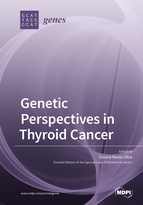Genetic Perspectives in Thyroid Cancer
A special issue of Genes (ISSN 2073-4425). This special issue belongs to the section "Human Genomics and Genetic Diseases".
Deadline for manuscript submissions: closed (31 July 2020) | Viewed by 20333
Special Issue Editor
Interests: breast cancer; thyroid cancer; genetic susceptibiliy; genetic variants; DNA repair
Special Issue Information
Dear Colleagues,
“Genetic Perspectives in Thyroid Cancer” is an issue that intends to cover several topics on thyroid cancer, including genetic analysis, genome sequence analysis, genome-wide analysis, gene expression regulation and also metabolomics and proteomics.
Thyroid cancer is an uncommon type of cancer, but it is one of the most common endocrine malignancies, with rising incidence over the last few decades. The aetiology of thyroid cancer is multifactorial, and radiation is the best documented risk factor related to the disease. Further risk factors have been hypothesized; however, we have yet to gather a wide range of information that will help us better understand the genetic mechanisms of thyroid cancer. The influence of genetics in the clinic and in therapeutics has been improved based on retrospective and prospective studies published worldwide in the last few decades, but the development of high through-put approaches has also been crucial.
The new advances in high through-put methodologies as Next Generation Sequencing will open the door to new genetic variants that will help to clarify genotype-phenotype correlations, new gene associations, new genetic targets useful as potential biomarkers, and so on. The new decade that now begins might provide new evidences for the disease—for which we count on you.
This Special Issue aims to reach new findings based on genetic evidences in thyroid cancer as expressed in case-studies, molecular approaches, and hereditary evidences, clinical and therapeutic developments. We would like to invite manuscripts that will help us broadly deepen our understanding of thyroid genetics.
Dr. Susana Nunes Silva
Guest Editor
Manuscript Submission Information
Manuscripts should be submitted online at www.mdpi.com by registering and logging in to this website. Once you are registered, click here to go to the submission form. Manuscripts can be submitted until the deadline. All submissions that pass pre-check are peer-reviewed. Accepted papers will be published continuously in the journal (as soon as accepted) and will be listed together on the special issue website. Research articles, review articles as well as short communications are invited. For planned papers, a title and short abstract (about 100 words) can be sent to the Editorial Office for announcement on this website.
Submitted manuscripts should not have been published previously, nor be under consideration for publication elsewhere (except conference proceedings papers). All manuscripts are thoroughly refereed through a single-blind peer-review process. A guide for authors and other relevant information for submission of manuscripts is available on the Instructions for Authors page. Genes is an international peer-reviewed open access monthly journal published by MDPI.
Please visit the Instructions for Authors page before submitting a manuscript. The Article Processing Charge (APC) for publication in this open access journal is 2600 CHF (Swiss Francs). Submitted papers should be well formatted and use good English. Authors may use MDPI's English editing service prior to publication or during author revisions.
Keywords
- Thyroid Cancer
- Genetic variants
- Thyroid Omics
- Biomarkers
- Susceptibility
- Risk Factors







